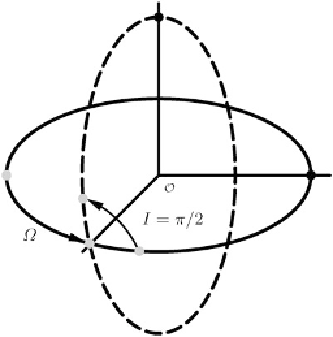Geography Reference
In-Depth Information
Forward problem.
Backward problem.
Input:
Λ, Φ
and
Ω,I
=
π/
2.
Input:
A, B
and
Ω,I
=
π/
2.
Output:
A, B
.
Output:
Λ, Φ
.
Within the forward problem, which is solved in Box
3.16
, we depart from (i) given spherical
longitude
Λ
and spherical latitude
Φ
of a point in the sphere
2
R
and from (ii) given longitude
of the ascending node
Ω
and inclination
I
=
π/
2 of the meta-equatorial plane in order to derive
(iii) meta-longitude
A
and meta-latitude
B
of the homologous point in the sphere. Conversely,
for solving the backward problem, which is outlined in Box
3.17
, we inject (i) meta-longitude
A
and meta-latitude
B
of a point in the sphere
S
S
2
R
and (ii) longitude of the ascending node
Ω
and inclination
I
=
π/
2 of the meta-equatorial plane in order to derive spherical longitude
Λ
and spherical latitude
Φ
of the homologous point in the sphere. Consult Fig.
3.9
,whichisan
illustration of the transverse aspect of the sphere.
Fig. 3.9.
The transverse aspect of the sphere
Box 3.16 (The forward problem of transforming spherical frames of reference: the transverse
aspect. Input variables:
Λ, Φ, Ω, I
=
π/
2. Output variables:
A, B
).
(i) Meta-longitude:
tan
Φ
cos(
Λ
tan
A
=
Ω
)
,
−
cos
A
=
cos
Φ
cos
B
cos(
Λ − Ω
)=
cos
Φ
cos(
Λ
−
Ω
)
1+cos
Φ
sin(
Λ − Ω
)
1
−
cos
Φ
sin(
Λ − Ω
)
,
=
(3.83)
sin
A
=
sin
Φ
cos
B
=










Search WWH ::

Custom Search